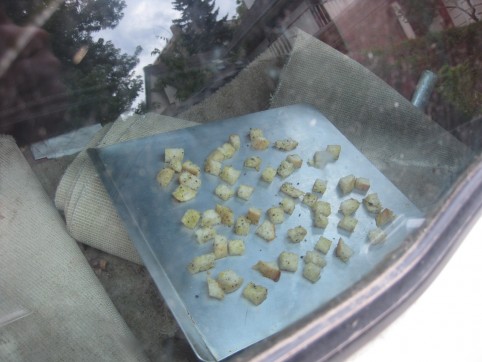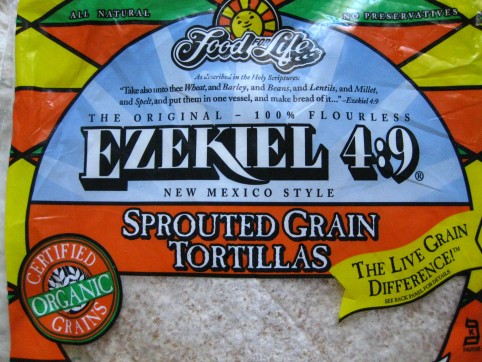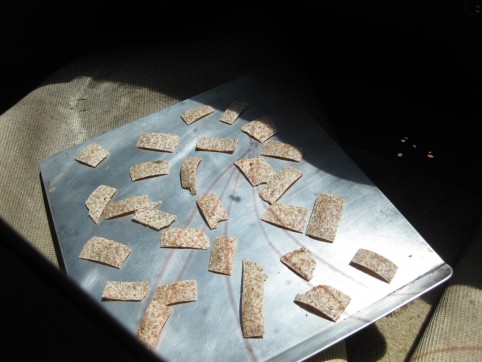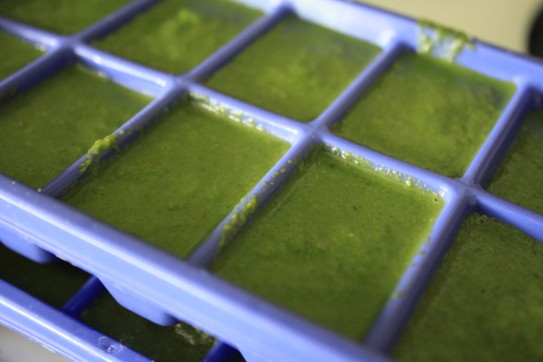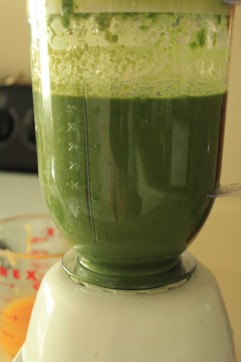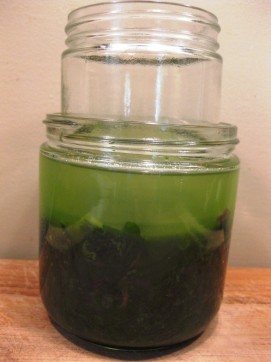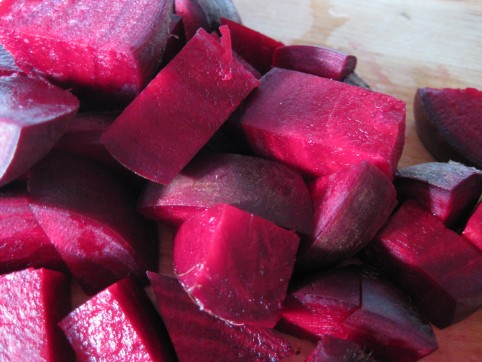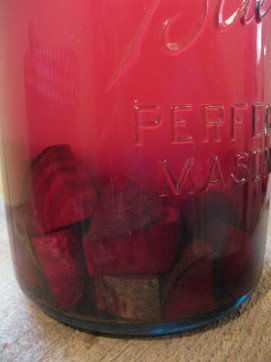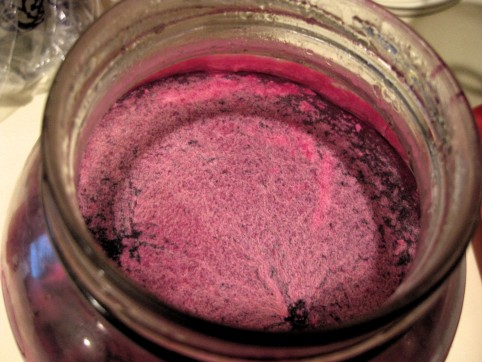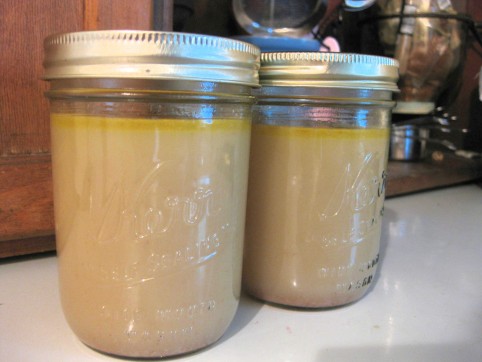
Chicken feet! In this post, I mentioned that I’d found pastured chicken feet at the farmer’s market, and how excited I was about that! (I bought them from the good folks at Cottonwood Creek Farms — their pastured chickens are awesome…if you’re in Colorado, definitely support these local farmers!) I made chicken-foot bone broth from them, and WOW. It’s incredible stuff. I was amazed at the amount of gelatin that ended up in the stock…three or four times the gelatinousness of Jello! A delicious, rich broth…rich without being fatty.
Calcium-rich bone broth (stock) is a staple in my kitchen; I make sure it’s always in my freezer. It adds so much nutrition to a dish, and the taste is incredible. It’s the cook’s secret weapon! Lentils made with homemade bone broth instead of water is an entirely different experience (and one of my all-time favorites!). I like to simmer down my bone broth till it’s really concentrated and delicious; it’s both easier to store — taking up less space in the freezer — and adds a deeper flavor to whatever I use it in. I could dilute the concentrate once I thaw it out, but usually I just use it straight.
And so, Why bone broth? Well I will tell you. Well actually I’ll let Sally Fallon tell you. She’s the author of one of my favorite cookbooks that I sometimes mention here, Nourishing Traditions.
“Meat and fish stocks are used almost universally in traditional cuisines — French, Italian, Chinese, Japanese, African, South American, Middle Eastern and Russian; but the use of homemade meat broths to produce nourishing and flavorful soups and sauces has almost completely disappeared from the American culinary tradition.
Properly prepared meat stocks are extremely nutritious, containing the minerals of bone, cartilage, marrow, and vegetables as electrolytes, a form that is easy to assimilate. Acidic wine or vinegar added during cooking helps to draw minerals, particularly calcium, magnesium and potassium, into the broth.
It was Dr. Pottenger who pointed out that stock is also of great value because it supplies hydrophilic colloids to the diet. Raw food compounds are colloidal and tend to be hydrophilic, meaning they attract liquids. Thus, when we eat a salad or some other raw food, the hydrophilic colloids attract digestive juices for rapid and effective digestion. Colloids that have been heated are generally hydrophobic — they repel liquids, making cooked foods harder to digest. However, the proteinaceous gelatin in meat broths has the unusual property of attracting liquids — it’s hydrophilic — even after it has been heated. The same property by which gelatin attracts water to form desserts, like Jello, allows it to attract digestive juices to the surface of cooked food particles.”
*****

*****
Below is the Chicken Stock recipe straight from Nourishing Traditions. Nowadays I stray from the recipe — no longer bothering to weigh or measure — and often leave the veggies out to achieve a truer chicken flavor. Sometimes I’ll add the veggies too, but never the carrots since I dislike the sweetness they impart.
Anyway, I simply dump some bones (usually chicken backs, feet, or the carcass from a whole chicken) into my crock pot, fill with cold water according to how many bones I have (this is all very unscientific — you’ll get a feel for it quickly). I tend to add less water than is called for in the original recipe because I like a very concentrated stock with lots of flavor. To the water, add a tablespoon or two of vinegar. Turn on your crock pot and let it simmer away for about 24 hours. I’ve also done this on the stove many times, but I definitely prefer the crock pot.
When it’s done, I pour everything through a strainer, reserving the bones and picking off any meat for another use. I like to munch on the ends of the bones (which will be very soft by then) — a great calcium & mineral supplement. Pour into jars (leaving at least an inch of head space if you’ll be freezing them), and place in the fridge so the fat can harden on the surface; if there’s lots of fat I’ll skim some off, but I do like to leave at least some. Use, or transfer to the freezer. (As a side note, I’ve noticed a big difference with stock made from pastured chickens — much less fat, much more gelatin!)
*****
Nourishing Traditions Chicken Stock
1 whole free-range chicken or 2-3 lbs of bony chicken parts, such as necks, backs, breastbones, and wings
gizzards from one chicken (optional)
feet from the chicken (optional)
4 quarts cold filtered water
2 Tbsp vinegar
1 large onion, coarsely chopped
2 carrots, coarsely chopped
3 celery stalks, coarsely chopped
1 bunch parsley
If you are using a whole chicken, cut off the wings and remove the neck, fat glands and the gizzards from the cavity. By all means, use chicken feet if you can find them — they are full of gelatin. (Jewish folklore considers the addition of chicken feet the secret to successful broth.) Even better, use a whole chicken, with the head on. These may be found in Oriental markets. Farm-raised, free-range chickens give the best results. Many battery-raised chickens will not produce stock that gels.
Cut chicken parts into several pieces. Place chicken or chicken pieces in a large stainless steel pot with water, vinegar, and all vegetables except parsley. Let stand 30 minutes to 1 hour. Bring to a boil, and remove scum that rises to the top. Reduce heat, cover and simmer for 6 to 24 hours. The longer you cook the stock, the richer and more flavorful it will be. About 10 minutes before finishing the stock, add parsley. This will impart additional mineral ions to the broth.
Remove whole chicken or chicken pieces with a slotted spoon. Remove meat and reserve for other uses, such as chicken salads, enchiladas, sandwiches, or curries. (The skin and smaller bones, which will be very soft, may be given to your dog or cat.) Strain the stock into a large bowl and reserve in your refrigerator until the fat rises to the top and congeals. Skim off this fat and reserve the stock in covered containers in your refrigerator or freezer.
*****

